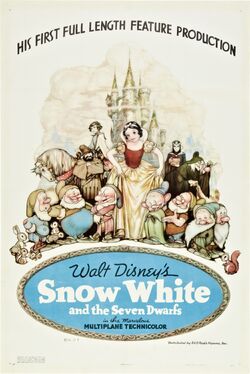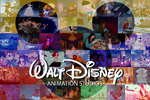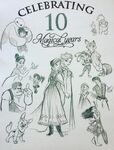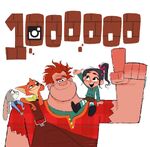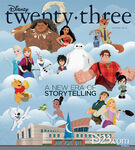Walt Disney Animation Studios (commonly nicknamed Disney Animation and Disney) is the name of the flagship studio of The Walt Disney Company. Founded by Walt Disney and Roy O. Disney, Walt Disney Animation Studios was developed as Disney Brothers Cartoon Studio after the closure of Disney’s previous venture, Laugh-O-Gram Studio. It would later be renamed as Walt Disney Studio, Walt Disney Productions, until being established as a subsidiary of what would become the greater Walt Disney Company following a corporate restructuring in the 1980s, under the name Walt Disney Feature Animation.
For nearly a century, Walt Disney Animation Studios has been the world’s leading animation division. Several innovation that had been pinoeered by the studio include sound cartoons in 1928, storyboarding and color cartoons in the 1930s, feature-length animated films in 1937, and the Xerox process in 1961. After numerous accolades for its features in the decades prior, in 1993, Beauty and the Beast became the first animated feature to be nominated for Best Picture at the Academy Awards. Several of the studio’s more recent features, including Frozen and Zootopia, have become some of the highest-grossing films of all time with over 1 billion at the worldwide box office.
Outside of feature films, the studio is most notable for introducing Mickey Mouse in Steamboat Willie on November 18, 1928. The inception of Mickey has been historically signified as the start of what is considered the Golden age of American animation. Today, the character serves as The Walt Disney Company’s mascot, and one of the highest-grossing media franchises in the world.[1]
In 2020, Walt Disney Animation Studios announced that they would begin producing television series in-house, which was previously unprecedented as the studio primarily produced short and feature-length films (in addition to occasional collaborations with other facets of the company, such as Disney Parks, Experiences and Products).
History
The Alice Comedies and Oswald the Lucky Rabbit
In early 1923, Kansas City, Missouri animator Walt Disney created a short film entitled Alice's Wonderland, which featured child actress Virginia Davis interacting with animated characters. Film distributor Margaret J. Winkler contacted Disney with plans to distribute a whole series of Alice Comedies based upon Alice's Wonderland. The contract signed, Walt and his brother Roy Disney moved to Los Angeles. On October 16, 1923, they officially set up shop in their uncle Robert Disney's garage, marking the beginning of the Disney Brothers Cartoon Studio (currently Walt Disney Animation Studios). Within a few months, the company moved into the back of a realty office in downtown Los Angeles, where production continued on the Alice Comedies until 1927. In January 1926, the studio moved to a newly constructed studio facility on Hyperion Avenue in the Silver Lake district of Los Angeles. At the same time, Walt renamed the company Walt Disney Studio.
After the end of the Alice Comedies, Disney developed an all-cartoon series for Winkler and Universal Pictures - Oswald the Lucky Rabbit. Universal owned the rights to the titular character while Winkler Pictures served as the "middleman" between Disney and Universal. Disney only completed 27 Oswald shorts before losing the contract in March 1928, when Winkler's husband Charles Mintz hired away all of Disney's animators to start his own animation studio. Notable animators that left Disney include Hugh Harman, Rudolf Ising, Robert McKimson, and Rollin Hamilton. Ub Iwerks was one of the few animators who stayed with Disney.
Mickey Mouse and Silly Symphonies
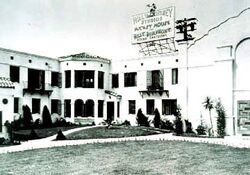
The Disney Studios building in the 1930s.
Following the loss of several animators, Walt Disney and Ub Iwerks created Mickey Mouse. Disney's first sound film Steamboat Willie, a cartoon starring Mickey, was released on November 18, 1928. It was the third Mickey Mouse cartoon, behind Plane Crazy and The Gallopin' Gaucho. It was also the first cartoon to feature synchronized sound. Disney used Pat Powers' Cinephone system, created by Powers using Lee De Forest's Phonofilm system. Steamboat Willie premiered at B. S. Moss's Colony Theater in New York City, now The Broadway Theatre.
A second Disney series of sound cartoons, the Silly Symphonies, debuted in 1929 with The Skeleton Dance. Each Silly Symphony was a one-shot cartoon centered around music or a particular theme.
On December 16, 1929, Walt Disney Studio's name was changed to Walt Disney Productions, Ltd. and a few subsidiaries were established - Walt Disney Enterprises (for merchandising), Disney Film Recording Company, Ltd. (for music), and Liled Realty and Investment Company (for real estate). On September 29, 1938, the company and subsidiaries were combined to create a single company titled Walt Disney Productions.
In 1930, disputes over finances between Disney and Powers led to Walt Disney Productions signing a new distribution contract with Columbia Pictures, and Powers signing away Ub Iwerks, who began producing cartoons at his own studio.
In 1932, Disney signed an exclusive contract with Technicolor (through the end of 1935) to produce cartoons in color, beginning with Flowers and Trees (1932). At the same time, Disney released future cartoons through United Artists until 1937, when United Artists attempted to attain future television rights to the Disney shorts. From 1937 to 1956, most of Disney's films would be distributed through RKO Radio Pictures.
Snow White and the Seven Dwarfs and World War II
A second Disney series of sound cartoons, the Silly Symphonies, debuted in 1929 with The Skeleton Dance. Each Silly Symphony was a one-shot cartoon centered around music or a particular theme. In 1930, disputes over finances between Disney and Powers led to Disney's studio, reincoporated the year before as Walt Disney Productions, signing a new distribution contract with Columbia Pictures, and Powers signing away Ub Iwerks, who bean producing cartoons at his own studio.
Columbia distributed Disney's shorts for two years before Walt Disney began production on his first feature-legnth animated film in 1934. Despite derision from most of the film industry, who dubbed the production "Disney's Folly", Disney proceeded undaunted into the production of Snow White and the Seven Dwarfs, which would become the first animated feature in English and Technicolor.
Considerable training, and development went into the production of Snow White, with Silly Symphonies such as The Goddess of Spring (1934) and The Old Mill serving as experimetation grounds for new techniques, including the animation of realistic human figures, special effects animation, and the use of multiplane camera, an invention which split animation artwork layers into severla planes, allowing the camera to appear to move dimensionally through an animated scene. Snow White cost Disney a then-expensive sum of $1.4 million to complete, and was an unprecedented success when released in February 1938, becoming the highest-grossing film of that time. Today, it is generally considered to be Walt Disney's most significant achievement, his first-ever animated feature. Snow White was the first major animated feature made in the United States, the most successful motion picture released in 1938, and, adjusted for inflation, is the tenth highest-grossing film of all time. This historical moment in motion picture history changed the medium of animation.
1935-1949: Pinocchio, Fantasia & WWII
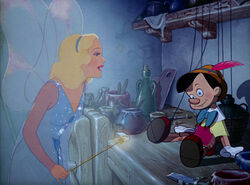
Despite being a financial disappointment upon its initial release, Pinocchio is widely regarded as the pinnacle of Disney animation.
Buoyed by Snow White's success, Disney began developing and producing more features. The second Disney feature, Pinocchio, Snow White was followed by Pinocchio and Fantasia in 1940, neither of which was a financial success when first released. Much of the character animation on these productions and all subsequent ones until the late 1970s was supervised by a braintrust of animators Walt Disney dubbed the "Nine Old Men", many of whom also served as directors on the Disney features: Frank Thomas, Ollie Johnston, Woolie Reitherman, Les Clark, Ward Kimball, Eric Larson, John Lounsbery, Milt Kahl, and Marc Davis.
The development of the feature animation department created a caste system at the Disney studio: lesser animators (and feature animators in-between assignments) were assigned to work on the short subjects, while animators higher in status at the studio worked on the features.
A bitter union strike in mid-1941 resulted in an exodus of several animation professionals from the studio, from top-level animators such as Art Babbitt and Bill Tylta to artists more known for later works such as Frank Tashlin, John Hubley, Maurice Noble, and Walt Kelly. The inexpensive Dumbo was released just before the United States' entry into World War II in 1941 and became a box office success, while Bambi did not see release until mid-1942.
Work on Bambi's intended follow-ups Alice in Wonderland and Peter Pan was put on hold, and the entire Disney studio instead focused on shorts, military training films, and war propaganda such as the live-action/animated feature Victory Through Air Power (1943). Beginning with Saludos Amigos in 1943, the Disney studio began producing inexpensive "package films": features made up of one or more short subjects tied together by live-action or animated framing material. Other features in this vein included The Three Caballeros (1944), Make Mine Music (1946), Song of the South (1946), Fun and Fancy Free (1947), and The Adventures of Ichabod and Mr. Toad (1949).
1950-1970:Impact and Aftermath of Walt Disney’s Death
The feature animation department was downsized considerably after the release of Sleeping Beauty in 1959 and a transition from hand-done inking of cels to xerography. One Hundred and One Dalmatians was Disney's first feature to make use of xerography, which used Xerox technology to help speed up production time. In 1962, Walt Disney shut down the studio's short subject department, focusing its attention mainly on television and feature film production (the studio would periodically produce featurettes and shorts on a sporadic basis, including films starring Winnie the Pooh, Mickey Mouse, and Roger Rabbit).
Walt Disney produced two more animated features during his lifetime, The Sword in the Stone (1963) and The Jungle Book (1967). He died shortly after of lung cancer.
After Walt Disney's death in 1966, the animation department continued with the films The Aristocats (1970) and Robin Hood (1973). During the production of Robin Hood and The Rescuers (1977), the aging members of the Nine Old Men began training replacements in anticipation of retirement. Led by Eric Larson, the training program would bring artists such as Don Bluth, Glen Keane, John Musker, and Ron Clements to the forefront of the studio's talent roster.
1970-1988: Post-Walt, Rival Studios and Corporate Reconstruction
Following two films with a mix of the younger and older animators, The Rescuers (1977) and the live-action/animated Pete's Dragon (1978), 11 of the younger animators, led by Bluth, Gary Goldman, and John Pomeroy, all resigned, claiming that the Disney animation studio had lost its way. Bluth went on to found his own studio, Don Bluth Productions, which produced its first film, the mildly successful The Secret of NIMH, in 1982. Don Bluth Productions became Disney's main competitor in the animation industry during the 1980s and early 1990s.
During the production of Robin Hood (1973) and The Rescuers (1977), the aging members of the Walt Disney studio's longtime core group of animators, known as the Nine Old Men, began training replacements in anticipation of retirement.
In 1979, during the production of The Fox and the Hound, 11 members of the new guard of animators, led by Don Bluth, Gary Goldman, and John Pomeroy, left the Disney studio, wanting to produce movies they felt were more in line with the style and quality of movies of Disney's golden years of the 1930s and 1940s, left Disney, taking 11 Disney animators with him to start his own rival studio, Don Bluth Productions. With 17% of the animators now gone, the release of The Fox and the Hound was delayed six months to June 1981. Don Bluth Productions eventually became Disney Animation's main competitor during the 1980s and early 1990s.
1984-1988: Corporate reconstruction
Walt Disney Productions underwent a major shakeup in the 1980s after narrowly escaping a hostile takeover attempt from Saul Steinberg. Michael Eisner, formerly of Paramount Pictures, became CEO in 1984, and was joined by his Paramount associate Jeffrey Katzenberg, while Frank Wells, formerly of Warner Bros., became president. After the disappointing box office performance of the 1985 PG-rated animated feature The Black Cauldron, the future of the animation department was in jeopardy.
The company considered shuttering its legacy animation studio. In the interest of saving what he believed to be the studio's core business, Roy E. Disney persuaded Eisner to let him supervise the animation department in the hopes of improving its fortunes. Eisner agreed, making Roy E. Disney chairman of the newly reorganized Walt Disney Feature Animation. Peter Schneider became the first president of Feature Animation at the studio.
On February 1, 1985, the entire animation staff was moved out of the Animation building on the Disney studio lot in Burbank, which was instead occupied by management and television production staff. The animation staff relocated to the Air Way complex, a former air hanger 20 miles away in Glendale.
The next feature for the restructured WDFA team was The Great Mouse Detective, begun by John Musker and Ron Clements as Basil of Baker Street after both left The Black Cauldron production team. Released in 1986, the film was a moderate box office success. Later the same year, Universal Pictures released Don Bluth's An American Tail, which outgrossed The Great Mouse Detective at the box office and became the highest-grossing first-issue animated film to that point. Two years later, the studios released Oliver & Company and The Land Before Time on the same weekend.
The Land Before Time made more cash at the box office on opening day. However, Oliver & Company beat out The Land Before Time at the domestic box office by $5,000,000. Earlier that same year, 1988, Disney collaborated with Steven Spielberg, a long-time animation fan, to produce Who Framed Roger Rabbit, a live action/animation hybrid which featured animated characters from several 1930s/1940s studios interacting with live actors. The film was a significant critical and commercial success, winning four Academy Awards and renewing interest in theatrical animated cartoons. Several WDFA members were loaned out to Richard Williams and Dale Baer's animation teams to work on Who Framed Roger Rabbit.
1989-1999: The Renaissance era
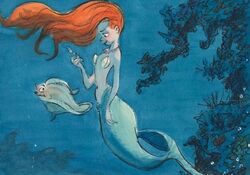
The story of a mermaid enthralled with the human world would forever change Disney animation.
Disney had been developing The Little Mermaid off and on as an animated property since the 1930s. By 1988, after the successes of Roger Rabbit, Oliver & Company, and The Great Mouse Detective, the studio decided to make it into an animated Broadway-like musical. Lyricist Howard Ashman and composer Alan Menken, who worked on Broadway productions such as Little Shop of Horrors, wrote the songs and score for the film, with Ashman also producing and heavily involved in the story development process.
The film was released on November 17, 1989 and garnered a higher weekend gross than Don Bluth's All Dogs Go to Heaven, which opened the same weekend. It went on to beat The Land Before Time's record and became the highest-grossing animated film at that time, earning $89 million at the US box office. The Little Mermaid was a critical and commercial success and received two Academy Awards, for Best Song and Best Score.
The Rescuers Down Under was released one year later (sequel to the The Rescuers). The Rescuers Down Under was a box office disappointment, earning only $47,431,461 in total box office revenue. However, the movie was notable for its' use of Pixar's Computer Animation Production System (better known by the acronym CAPS), and became the first movie to be 100% digitally produced.
The following year, in 1991, came Beauty and the Beast, which is often considered by many to be the crown jewel of of all Disney animated films. It was the first animated film nominated for Best Picture at the Oscars, an accomplishment which has not been matched since Pixar's 2009 film Up, only to lose out to The Silence of the Lambs.
However, the film won Best Picture (Musical or Comedy) at the Golden Globe Awards and won two Academy Awards for Best Original Song and Best Original Score. The film was dedicated to Howard Ashman, who died earlier in the year before the film's release due to AIDS-related illness. It became the most successful animated feature in motion picture history up to that time, with domestic box office revenues exceeding $140 million.
As of 2009, ties with Disney/Pixar's WALL-E for the record of animated film with most Academy Award nominations (six). Aladdin and The Lion King followed in 1992 and 1994, respectively. Both films were highest worldwide grosses of their release year, but The Lion King became the highest-grossing animated film ever at the time and remains the highest grossing traditionally animated film in history.
Along with that, the films won Academy Awards for Best Original Song and Best Original Score in the footsteps of Beauty and the Beast. Howard Ashman wrote several songs for Aladdin before his death, but only three were finally used in the film. Tim Rice joined the project and completed the score and songs with Alan Menken. Tim Rice went on to collaborate with Elton John in The Lion King.
Pocahontas and The Hunchback of Notre Dame were also in the Disney Renaissance. Despite mature subjects and appealing more towards adults than children both were box-office successes and received general approval and acclaim. Pocahontas received two Academy Awards for Best Score and Best Original Song for Colors of the Wind. Both were successful with songs written by Alan Menken and Stephen Schwartz.
Pocahontas was into a critical success, Hunchback was not a commercial success; Although Pocahontas was met with mixed reception, and The Hunchback of Notre Dame was met with favorable reception. Disney continued on with successes from Hercules with songs by Alan Menken and David Zippel, (Hercules was not a big success, but a moderate success) Mulan with score by Jerry Goldsmith and songs by Matthew Wilder and David Zippel, and Tarzan with songs by Phil Collins.
2000-2005: Post-Renaissance era
By 2000, the Disney Renaissance had come to an end. Disney continued to release small successes such as Dinosaur, The Emperor's New Groove, and Atlantis: The Lost Empire, but also suffered box office disappointments with Treasure Planet, Brother Bear, and Home on the Range. The other films (Fantasia 2000 and Lilo & Stitch) received very positive reviews and were box office successes.
However, the expansion coincided with a decline in both revenue and quality of the department's output. Competition from other studios drove animator salaries to a high level, making traditional animated features a costly proposition and, beginning in 2000, massive layoffs brought staff numbers down to 600. Deciding that the reason for its unsuccessful box office draw was the fact that they still used traditional animation methods in a time when Pixar Animation Studios, DreamWorks Pictures and Blue Sky Studios were producing highly-successful CGI films, Disney converted WDFA into a CGI studio, performing more layoffs and selling off its traditional animation equipment. The Paris studio was shut down in 2003 and the Orlando studio followed suit in 2004.
After the financial failure of their last few animated features, compared to the immense success of other studios creating films entirely through computer animation, Walt Disney Animation Studios once announced that Home on the Range would be the last 2D-traditional animated film. In 2005, Chicken Little, the studios' first full length CGI animated feature, received generally mixed to negative reviews from critics, though it performed well at the box office.
2006-2008: Lasseter takes charge
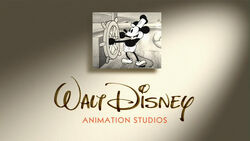
The current logo for the studio that has been used since Meet the Robinsons.
In 2006, The Walt Disney Company purchased Pixar for US$7.4 billion, and hired Pixar executives Ed Catmull and John Lasseter to serve as president and Chief Creative Officer, respectively, for both Pixar and Disney Feature Animation, in which the latter was renamed to Walt Disney Animation Studios.
Before the release of Lasseter's first original project, several other animated features, which were already in development before the arrival of Catmull and Lasseter, were in the midst of being released, these being Meet the Robinsons and Bolt. Both films received major adjustments after Lasseter's disapproval toward their initial pitches. Robinsons was a box office failure, and received mixed to positive reviews, while the following Bolt received critical acclaim and was a modest box office success.
In between these films, the studio also released the animated short How to Hook Up Your Home Theater, done with traditional animation.
2009-present: The New Era
- “I think what's exciting is, not just bringing back hand-drawn animation, but bringing back a Disney animated film. We haven't seen one of these in such a long time.”
- ―John Lasseter during a press interview for The Princess and the Frog.[2]
Back in 2006, with The Walt Disney Company's acquisition of Pixar, it was announced that Lasseter's first order of business was to revive the classic Disney "fairytale" formula, with an animated project done primarily with traditional-animation. This was a response to the misconception that the world had grown "too cynical" for traditional fairytales, resulting in the studio abandoning all fairytale adaptations prior.[3] To revive the genre, Lasseter rehired directors of The Little Mermaid and Aladdin, John Musker and Ron Clements, who pitched a musical adaptation of "The Frog Prince", set in New Orleans and with an African-American princess as the lead heroine. The Princess and the Frog became the first project greenlit by Lasseter, and production quickly began, with many of the artists and animators from the Renaissance era, returning to work on the film.[4]
In 2009, The Princess and the Frog was released worldwide, and reached critical acclaim amongst critics and audiences alike, being praised as a "return to form" for the studio[5][6] The film transcended its initial release, with the characters and story having been integrated in various divisions across the company, including the Disney Princess franchise, and the Walt Disney Parks and Resorts around the world, thus becoming a staple in both the company's legacy, and pop-culture; the first project from the studio to do so in nearly a decade. Today, some critics and pundits regard The Princess and the Frog as the modern turning point for the studio, and the film to have ignited what is currently considered Disney Animation's contemporary renessaince.[7][8][9]
Unfortunately, while not a bomb, the box office returns for Frog were lower than the studio expected, bringing in $267,045,057 worldwide, and thus labeling the film as a financial disappointment. The title, which has the word "Princess", was blamed, as it supposedly turned away male audience members. As a result, the two following fairytale adaptation titles of "Rapunzel" and "The Snow Queen" garnered new, gender-neutral titles. In 2010, the studio released their version of "Rapunzel", Tangled, which gained widespread positive reviews and became a box office hit. Not only was Tangled the most successful film from the studio since 1994's The Lion King, it was also the film to have ignited a new method of artistic style, having uniquely blended features of both computer-generated imagery and traditional animation, while using non-photorealistic rendering, which gave the film the appearance of classic Disney animated features, despite being crafted in computer animation. Tangled's marketing, which relied heavily on action and pop-cultural references, was also a massive change from the studio's previous methods. Both the artistic style and marketing featured with Tangled would go on to become an influence for all computer-animated films to follow.
In 2011, the studio released its second traditionally animated film of the contemporary regime, Winnie the Pooh. Due to the film being released on the same date as another highly anticipated feature, the film's box office was low, however the film gained universal acclaim and became the best reviewed animated film of 2011. Along with the film, the studio released the short The Ballad of Nessie with it. Pooh was also significant in that it introduced songwriter duo, Kristen Anderson-Lopez and Robert Lopez, as well as composer Henry Jackman, to the studio; all of whom would become recurring members of the filmaking teams of following, successful features.
On November 2, 2012, the studio would break the box-office record for the most money made on opening weekend for the entire Disney animated canon with the computer animated Wreck-It Ralph, based on the concept of centering a film around video games that dates all the way back to the 1980s, and was greenlit by Lasseter in 2009.[10] Along with Ralph, the short Paperman was released, which broke ground with the use of the Meander software, which is a literal blend of traditional and computer animation. Wreck-It Ralph would go on to win numerous accolades for the studio, while Paperman became the first Walt Disney Animation Studios short to win the Academy Award for Best Short since 1969's It's Tough to Be a Bird.
In April 2013, Walt Disney Animation Studios laid off fewer than 10 people out of a staff of more than 800. Because a majority of them were hand-drawn animators, there was exaggerated speculation on some animation blogs that the studio was abandoning traditional animation once again, an idea that the studio dismissed.
In 2013, the studio released its version of "The Snow Queen', retitled Frozen, its 53rd full-length animated film, on November 27. 2013. Like "Rapunzel" and "The Frog Prince" before it, the idea to develop an animated version of "The Snow Queen" had been circling throughout the studio for decades, but complications with the story prevented anything from coming to light. In 2008, however, John Lasseter approached director of Tarzan, Chris Buck, to helm a new tackling of the project. Once again, complications with the story interfered, but the project eventually moved forward once more in 2011, with the addition of writer Jennifer Lee, who previously worked on Wreck-It Ralph, as co-director, as well as Kristen and Robert Lopez, who developed both the songs and key story points for the film.[11][12] Frozen broke numerous records with widespread critical acclaim, and became a financial juggernaut, eventually surpassing The Lion King as the studio's highest-grossing film, and soon became the highest-grossing animated film of all time. In 2014, Frozen won both Academy Award nominations for Best Animated Feature and Best Original Song with "Let It Go". The overwhelming success of Frozen, in the eyes of various film pundits, solidified the idea that the Walt Disney Animation Studios was in the midst of a modern renaissance.[13]
The 54th feature, Big Hero 6, was released on November 7, 2014, and is the first in the Canon series to use Marvel Comics characters. The film performed well with critics, and though it couldn't match up with Frozen's box-office performance, it still earned over $652 million ($222.5 million in the US) and won the Best Animated Feature Oscar for WDAS for a 2nd straight year.
On March 4, 2016, the studio released its 55th animated feature film, Zootopia. Centered around the modern world of anthropomorphic animals, Zootopia became a surprise hit for the studio, mirroring the success of Frozen. The film garnered universal acclaim amongst critics, being praised for its timely and mature themes and well-written characters, among other feats. Financially, Zootopia would go on to become Disney Animation's second highest-grossing feature, behind only Frozen, with a worldwide box office total of over $1 billion; the fourth animated film to ever reach the milestone. Additionally, with Zootopia's record-breaking success, Walt Disney Animation Studios became the first animation studio in history to have more than one film pass the billion dollar mark at the global box office.
Even further cementing its critical successs, Zootopia was honored by the American Film Institute as one of the top ten films of 2016, a feat extremely rare for animated motion pictures. Zootopia also earned the studio its third consecutive win for the Best Animated Feature category at the 89th Academy Awards.
Eight months following Zootopia, the studio released their 56th feature film, Moana, centering the daughter of a chief embarking on a journey to save her Polynesian island. It was the seventh film to be directed by John Musker and Ron Celemens, and was a box office and critical success, grossing $600 million worldwide. New technology was created for the water, lava and hair effects. Moana also featured a heavy dose of hand-drawn animation, most notably in Maui's tattoos. The studio's next short, Inner Workings, was released alongside Moana.
In 2017, John Lasseter took a six month leave from both Walt Disney Animation and Pixar due to controversies. Olaf's Frozen Adventure, a theatrical featurette, was released alongside Pixar's Coco in November.
In 2018, it was formally announced that Lasseter would officially step down and be replaced by Jennifer Lee as Chief Creative Officer of the studio. Not long after, Ed Catmull announced his retirement from the Disney company. In the fall, Ralph Breaks the Internet was released to widely positive acclaim and was a financial success, out-grossing the original Wreck-It Ralph with over $500 million at the worldwide box office.
In 2019, Frozen II was released to mostly positive reviews and financial success, having the highest all-time worldwide opening for an animated film and eventually becoming the second highest-grossing animated film of all time (behind Disney’s The Lion King remake).
Currently in production at the studio are Raya and the Last Dragon (2021) and Encanto (2021), and several short and long-form series being developed for the Disney+ streaming service including Baymax! (2022), Zootopia+ (2022), Tiana (2023), and Moana, The Series (2023).
Filmography
- Main article: List of Disney theatrical animated features
Gallery
External links
 Walt Disney Animation Studios on Wikipedia
Walt Disney Animation Studios on Wikipedia- Official website
- Walt Disney Animation Studios Wikia
- Template:Twitter
 Walt Disney Animation Studios on Facebook
Walt Disney Animation Studios on Facebook Walt Disney Animation Studios on Instagram
Walt Disney Animation Studios on Instagram Walt Disney Animation Studios on YouTube
Walt Disney Animation Studios on YouTube Walt Disney Animation Studios on IMDb
Walt Disney Animation Studios on IMDb
References
- ↑ World’s 25 Most Successful Media Franchises, and How They Stay Relevant
- ↑ John Lasseter Interview
- ↑ John Lasseter interview with Telegrapg
- ↑ 'The Princess and the Frog Blu-ray and DVD. Audio commentary. Walt Disney Studios Home Entertainment. 2011
- ↑ Collider The Princess and the Frog review
- ↑ Examiner The Princess and the Frog review
- ↑ Forbes review Big Hero 6
- ↑ The Wrap interview with John Lasseter
- ↑ TIME Big Hero 6 review
- ↑ Rich Moore Looks Back at the Roads Not Taken With Disney's Wreck-It Ralph
- ↑ Frozen development announcement
- ↑ Frozen Producer Heads to the Oscars
- ↑ Disney seeks to crown revival with 'Frozen' Oscar gold
| v - e - d | ||||||||||||||
|---|---|---|---|---|---|---|---|---|---|---|---|---|---|---|
|

